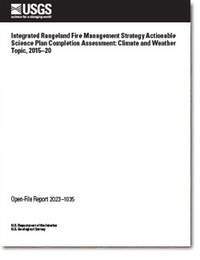Integrated Rangeland Fire Management Strategy Actionable Science Plan Completion Assessment: Climate and Weather Topic, 2015–20
Links
- Document: Report (5.3 MB pdf) , HTML , XML
- Related Works:
- OFR 2023-1003 — Integrated rangeland fire management strategy actionable science plan completion assessment—Invasives topic, 2015–20
- OFR 2023-1004 — Integrated rangeland fire management strategy actionable science plan completion assessment—Restoration topic, 2015–20
- OFR 2023-1009 — Integrated rangeland fire management strategy actionable science plan completion assessment—Fire topic, 2015–20
- OFR 2023-1010 — Integrated rangeland fire management strategy actionable science plan completion assessment—Sagebrush and sage-grouse topic, 2015–20
- Download citation as: RIS | Dublin Core
Abstract
Loss and degradation of sagebrush (Artemisia spp.) rangelands due to an accelerated invasive annual grass-wildfire cycle and other stressors are significant management, conservation, and economic issues in the western U.S. These sagebrush rangelands comprise a unique biome spanning 11 states, support over 350 wildlife species, and provide important ecosystem services that include stabilizing the economies of western communities. Impacts to sagebrush ecosystem processes over large areas due to the annual grass-wildfire cycle necessitated the development of a coordinated, science-based strategy for improving efforts to achieve long-term protection, conservation, and restoration of sagebrush rangelands, which was framed in 2015 under the Integrated Rangeland Fire Management Strategy (IRFMS). Central to this effort was the development of an Actionable Science Plan (Plan) that identified 37 priority science needs (hereinafter, “Needs”) for informing the actions proposed under the five topics (Fire, Invasives, Restoration, Sagebrush and Sage-Grouse (Centrocercus urophasianus), Climate and Weather) that were part of the collective focus of the IRFMS. Notable keys to this effort were identification of the Needs co-produced by managers and researchers, and a focus on resulting science being “actionable.”
Substantial investments aimed at fulfilling the Needs identified in the Plan have been made since its release in 2016. While the state of the science has advanced considerably, the extent to which knowledge gaps remain relative to identified Needs is relatively unknown. Moreover, new Needs have likely emerged since the original strategy as results from actionable science reveal new questions and possible (yet untested) solutions. A quantifiable assessment of the progress made on the original science Needs can identify unresolved gaps and new information that can help inform prioritization of future research efforts.
This report details a systematic literature review that evaluated how well peer-reviewed journal articles and formal technical reports published between January 1, 2015, and December 31, 2020, addressed four Needs identified under the Climate and Weather topic in the Plan. The topic outlined research Needs broadly focused on understanding the potential effects of climate change on vegetative resilience to inform restoration of sagebrush rangelands. We established the level of progress towards addressing each Need following a standardized set of criteria, and developed summaries detailing how research objectives nested within Needs identified in the Plan (hereinafter, “Next Steps”) were either addressed well, partially addressed or remain outstanding (that is, addressed poorly) in the literature through 2020. Our searches resulted in the inclusion of 92 science products that at least partially addressed a Need identified in the Climate and Weather topic. The Needs that were well and partially addressed included:
- studies of the complex set of climatic relationships that influence sagebrush rangeland restoration and seeding success;
- the identification of seed collection areas across the range of environmental variability inhabited by target restoration species; and
- develop predictive models to assess targeted restoration species’ responses to mid-century climatic conditions.
The Need addressed poorly was the identification of native plant species, genotypes and ecotypes, and seed mixes that may be resilient to a changing climate. The information provided in this assessment will assist updating the Plan, and can inform updates of other relevant science planning documents as needed.
Suggested Citation
Anthony, C.R., Holloran, M.J., Ricca, M.A., Hanser, S.E., Phillips, S.L., Steblein, P., and Wiechman, L.A., 2023, Integrated rangeland fire management strategy actionable science plan completion assessment— Climate and weather topic, 2015–20: U.S. Geological Survey Open-File Report 2023–1035, 21 p., https://doi.org/10.3133/ofr20231035.
ISSN: 2331-1258 (online)
Study Area
Table of Contents
- Acknowledgments
- Abstract
- Introduction
- Methods
- Results and Summary
- References Cited
- Glossary
- Appendix 1
| Publication type | Report |
|---|---|
| Publication Subtype | USGS Numbered Series |
| Title | Integrated rangeland fire management strategy actionable science plan completion assessment— Climate and weather topic, 2015–20 |
| Series title | Open-File Report |
| Series number | 2023-1035 |
| DOI | 10.3133/ofr20231035 |
| Publication Date | June 27, 2023 |
| Year Published | 2023 |
| Language | English |
| Publisher | U.S. Geological Survey |
| Publisher location | Reston, VA |
| Contributing office(s) | Forest and Rangeland Ecosystem Science Center, Fort Collins Science Center, Western Ecological Research Center |
| Description | vi, 21 p. |
| Country | United States |
| Online Only (Y/N) | Y |


